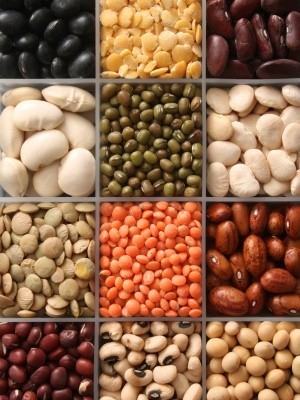
Most people love a great chili or baked beans, but most people don't know how to identify the beans in any dish. Beans are a great way to stretch your food budget and can feed a crowd.
They are a great source of protein and when teamed with rice or other grains, meat, or cheese they make a complete protein. Beans are full of good carbohydrates along with being a great source for iron and calcium. With fiber galore, beans aid the digestion process. Beans are great for people who suffer from osteoporosis or anemia and because they slow the rise in blood sugar after a meal they are a good choice for diabetics. Beans are also high in antioxidants. This article is going to give you lots of good information on beans and what the different kinds are.
Adzuki: These beans are used in Asian cuisine and are popular in Japanese cooking for confections. These are small, reddish-brown beans, rounded in shape with a point at one end. They have a distinctive white ridge along one side. They have a strong, nutty, sweet flavor. Adzuki beans can be purchased whole or powdered at Asian markets and are used to make red sweet bean paste.
Cooking Time: 3/4 to 1 hour
Anasazi: These beans are small kidney shaped purple and white beans in the same family as pinto beans. These heirloom beans are sweet, fast-cooking, and reputed to cause less flatulence than other bean varieties. They're great for making refried beans.
Cooking time: 2 hours
Black: These beans are small ovals with deep black skins they have a dark cream to gray flesh and have a mild sweet texture and taste. They are some times called Turtle beans. These beans are a staple of Latin American and Caribbean cuisine, where they're used to make side dishes, soups, bean dips, and salads. They have a strong, earthy flavor, so they're often combined with strong spices.
Cooking Time: 1 to 1 1/2 hours
Black-Eye: These beans are kidney shaped and they have a white skin with a small black eye and have a flavor all their own. These are used in Southern cooking and African cooking. They are also called cowpeas or black eyed peas. These small beans cook quickly and require no presoaking.
Cooking Time: 1/2 to 1 hour
Cannellini These are large white beans, about 1/2" long, with a firm texture and skin and a nut-like flavor. They are also know as White Kidney beans and can be used just like kidney beans. Cannellini beans are used in Italian dishes but are also great in bean salads or soups.
Equivalents: 1 cup dried beans yields 2 1/2 cups cooked beans
Cooking time: 1 hour
Cranberry: These beans are usually white or cream in color with deep red or cranberry marks that are distributed in different patterns on the bean that disappear on cooking. The flavor of this bean has a nut like taste that is comparable to a chestnut. These are use in Italian, Spanish and Portuguese food.
Equivalents: 1 pound beans = 2 cups dried beans = 4-5 cups cooked beans.
Cooking Time: 3/4 to 1 hour
Garbanzo: These beans are beige to pale yellow but also can be green, red or brown. Garbanzo beans have a delicious nutlike taste and a texture that is buttery, yet somewhat starchy and pasty. They are also called chickpeas and are used in Middle Eastern, Indian dishes like hummus, falafels and curries.
Equivalents: 1 pound beans = 2 cups dried beans = 4-5 cups cooked beans.
Cooking Time: 1 to 1 1/2 hours
Great Northern: These beans are a flat, kidney-shaped, medium-sized bean, that is white in color. They have a mild flavor that is delicate which takes on the flavors of other foods which they are cooked. They are used in French cooking in cassoulet, in soups and stews and are the beans used in Boston baked beans.
Equivalents: 1 pound beans = 2 cups dried beans = 4-5 cups cooked beans.
Cooking Time: 3/4 to 1 hour
Kidney (Light Red): These beans are large and kidney-shaped. They have a full bodied flavor which is robust and a soft texture. These beans are popular in Caribbean cuisine and often paired with rice.
Equivalents: 1 pound beans = 2 cups dried beans = 4-5 cups cooked beans.
Cooking Time: 1 to 1/2 hours
Kidney (Dark Red): These beans are large, kidney-shaped, deep reddish-brown in color. They have a robust full bodied taste with a soft texture. They are used in chili and 3 bean salad and are the beans used in red beans and rice.
Equivalents: 1 pound beans = 2 cups dried beans = 4-5 cups cooked beans.
Cooking Time: 1 1/2 to 2 hours
Lima (Baby): These beans are flat shaped and creamy white in color and have a rich buttery flavor. They are used in southern cooking where they are a mainstay and in soups, stews and casseroles or can be cooked as a side dish cooked with herbs and spices.
Cooking Time: 1 hour
Lima (Large) : These beans have a flat shape and are ivory color in color. They have a smooth and creamy sweet taste. They are also called Butter beans in the south. They are a good substitute for potatoes or rice; excellent in soups, casseroles.
Equivalents: 1 pound beans = 2 cups dried beans = 4-5 cups cooked beans.
Cooking Time: 1 to 1 1/2 hours
Navy: These beans are small white ovals. They have a mild flavor and a powdery texture. They are also called pea beans and are used in pork and beans and baked beans but are most famous used in soups like Senate Navy bean soup.
Equivalents: 1 pound beans = 2 cups dried beans = 4-5 cups cooked beans.
Cooking Time: 1 1/2 to 2 hours
Pink: These beans are small, pale-pink and turn reddish brown when cooked. They have a rich and meaty flavor and a slightly powdery texture. They are a relative of the kidney bean and are used in southwestern chili and any where a small bean is desired.
Equivalents: 1 pound beans = 2 cups dried beans = 4-5 cups cooked beans.
Cooking Time: 1 hour
Pinto: These beans are medium ovals that have mottled beige and brown coloring that turn brown when cooked. These beans are used in Mexican cooking and can also be used to make pork and beans and refried beans.
Equivalents: 1 pound beans = 2 cups dried beans = 4-5 cups cooked beans.
Cooking Time: 1 1/2 to 2 hours
Small Red: These beans are dark red in color and they are similar to red kidney but smaller. They also have a flavor similar to red kidney beans. These beans are also called Mexican red beans. They hold both there shape and firmness when cooked. They are used in soups and salads and chili and creole dishes.
Equivalents: 1 pound beans = 2 cups dried beans = 4-5 cups cooked beans.
Cooking Time: 1 to 1 1/2 hours
This article can be printed out and put in a notebook for future reference. Hope you enjoy this article and I hope this helps you the next time you are in the store staring at all the different beans. Also try your health food or natural food stores they can some more unusual beans for you to try.

About The Author: Debra Frick is a mother of 5 and a grandmother to 8 grandsons and one granddaughter. She is a published author and poetress. Recycling and saving money are her passions. She also loves crocheting and cooking. She is also a pet rescue volunteer and has many pets of her own.
Add your voice! Click below to comment. ThriftyFun is powered by your wisdom!
Anasazi beans can be gotten in my area from www.amazon.com for far cheaper than can be gotten locally from Bob's red mill; both my neighbor and I were extremely happy with trying this new to us variety of beans! really outstanding bean in our opinion!
I beg to differ with Debra from Colorado on two counts.
1. Black-eyed peas may be called cow peas by some. While they are a sub species of the cow pea, they should not be confused with them as they have a decidedly distinct and different taste.
2. Great Northern beans are not flat. They are the size and shape of the pinto bean.
Soaking dry beans, particularly pintos and great northerns is a matter of preference. It reduces cooking time significantly. To reduce cooking time even further, the beans can be brought to a boil and then allowed to cool. Covered, they sit overnight. The soak water should be drained from the beans and fresh water added prior to cooking.
Meat flavoring ('now a days'), is also a matter of preference. When I was a child, these beans were always flavored with fat back. That's all we could afford. To me, at the time, I thought they were good. Ham hock has a decidedly 'old' and 'off' taste and adds the same to the beans. I choose not to use it. The absolute best pintos I ever tasted were those I cooked myself. They were seasoned with bits of ham and a bit of ham fat, both trimmed from the bone of a sugar cured, hickory smoked, Thanksgiving ham.
Stove top or crock pot? Again, this is a matter of preference. I prefer the stove top as I believe bringing the beans to a full rolling boil and keeping them there for about 20 minutes before simmering til done, greatly improves both taste and texture. I don't own a crock pot, but I don't think they reach a temperature to do this.
On gas:
I don't know why it's called 'flatulence'. When I was a little boy and ate too many pinto beans, my belly would really 'pooch out' there. Honey, there was nothing 'flat' about it. Relief was found while alone and preferably in the back yard.
Add your voice! Click below to comment. ThriftyFun is powered by your wisdom!